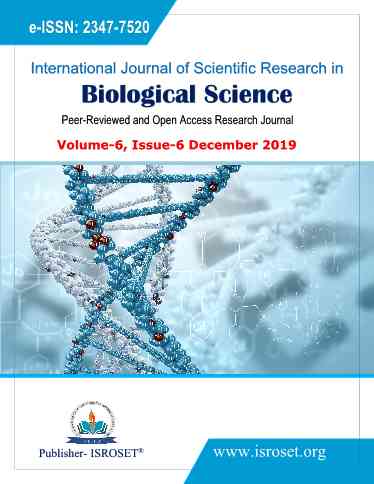Statistical Modeling of the Impact of Major Insect Pests of Watermelon on its Agronomic Performance: Linear Regression Perspective
Keywords:
Flower sex ratio, leaf-feeding beetles, leaf injury, plant survival rateAbstract
Studies on the impact of major pests of watermelon on its agronomic performance are hard to find. This paper presents the relationship between the agronomic performance of watermelon and density of its major insect pests with the aid of correlation and linear regression models using data collected from forty (40 m2) plots grouped into 4 replicates (10 plots/replicate) in field experiments in the early- and late-sown crop of 2016 and 2017 in the Research Farm of Federal University, Wukari, Nigeria. Plant survival rate (%) negatively and significantly (P < 0.05) correlated with each of mean number leaf-feeding beetles, A. gossypii density and B tabaci density in both the early- and late-sown crops of 2016, respectively; with a similar trend in 2017. All parameters significantly (P < 0.05) fitted the linear regression model. Densities of all major pests consistently correlated negatively and significantly with fruit yield. Student’s t-test detected significant differences between the pest and agronomic characters of the early- and late-sown crops of both years. We therefore conclude that watermelon experiences multiple pest infestations whose compositions and intensities vary between seasons and that, their influence on agronomic performance as shown by the coefficient of determination (R2) values (which were indicative of the effect of pests on crop performance) were largely > 50 %. Lower pest infestation (frequency and intensity) was also empirically shown to give rise to better growth indices and higher yields.
References
S. Shagufta. Fruits and vegetables production, African Publishing House, Ibadan, Nigeria, 420pp, 2012.
F.O. Alao, T.A. Adebayo. Comparative efficacy of Tephrosia vogelii and Moringa oleifera against insect pests of Watermelon, International Letters Natural Science, 35, 71-78, 2015.
E. Okrikata, E.O. Ogunwolu, M.U. Ukwela. Diversity, spatial and temporal distribution of above-ground arthropods associated with watermelon in the Nigerian Southern Guinea Savanna, Journal of Insect Biodiversity and Systematics, 5(1): 11–32, 2019.
M. Donatelli, R.D. Magarey, S. Bregaglio, L. Willocquet, J.P.M. Whish, S. Savary. Modelling the impacts of pests and diseases on agricultural systems, Agricultural Systems, 155: 213-24. 2017. DOI: 10.1016/j.agsy.2017.01.019
E. Okrikata, O.A. Yusuf. Diversity and abundance of insects in Wukari, Taraba State, Nigeria, International Biological Biomedical Journal, 2(4): 156–66, 2016.
R. Trusca, I. Grozea, R. Stef. Attractiveness and injury levels of adults by Diabrotica virgifera virgifera (Le Conte) on different host plant, Journal of Food, Agriculture and Environment, 2(3 and 4): 773–76, 2013.
E. Okrikata, E.O. Ogunwolu. Determination of the critical period of cyper-diforce® treatment against arthropod fauna and productivity of watermelon, Iraqi Journal of Science, 60(9): 1904-19, 2019. DOI: 10.24996/ijs.2019.60.9.3
P.D. Esker, S. Savary, N. McRoberts. Crop loss analysis and global food supply: focusing now on required harvests, CAB Rev. 7(52): 1-13, 2012. DOI: 10.1079/PAVSNNR20127052
J.P.M. Whish, N.I. Herrmann, N.A. White, A.D. Moore, D.J. Kriticos. Integrating pest population models with biophysical crop models to better represent the farming system, Environ. Model Software, 72: 418–25. 2015. DOI: 10.1016/j.envsoft.2014.10.010
M.M. Degri, H.S. Sharah. Field evaluation of two aqueous plant extracts on watermelon Citrullus lanatus (Thunb.) insect pest in Northern Guinea Savannah of Nigeria, International Letters of Natural Science, 14: 59–67, 2014.
J. Liu, S. Legarrea, M.R. Kent. Tomato reproductive success is equally affected by herbivores that induce or that suppress defenses, Frontiers of Plant Science, 8: 2128, 2017. DOI: 10.3389/fpls.2017.02128
G. Zehnder. Management of cucumber beetles and bacterial wilts of cucurbits. Alabama Cooperative Extension System, Alabama A and M University and, Auburn University, PubID: ANR-1026. 4pp, 1997.
T.W. Sappington, L.S. Hesler, K.C. Allen, R.G. Lutrell, S.K. Papiernik. Prevalence of sporadic insect pests of seedling corn and factors affecting risk of infestation, Journal of Integrated Pest Management, 9(1): 1–27, 2018. DOI: 10.1093/jipm/pmx020
M. Poornima. Effect of weather parameters on incidence of major pests and their natural enemies in few selected kharif and rabi crops, PhD. Thesis, University of Dhaward, 305pp, 2013.
J.S. Bale, G.J. Masters, I.D. Hodkinson, C. Awmack, T.M. Bezemer, V.K. Brown, J. Butterfield, A. Buse, J.C. Coulson, J. Farrar, J.E.G. Good, R. Harrington, S. Hartley, T.H. Jones, R.I. Lindroth, M.C. Press, I. Symrnioudis, A.D. Watt, J.B. Whittaker. Herbivory in global climate change research: direct effects of rising temperature on insect herbivores, Global Change Biology, 8:1-16, 2002.
Downloads
Published
How to Cite
Issue
Section
License

This work is licensed under a Creative Commons Attribution 4.0 International License.
Authors contributing to this journal agree to publish their articles under the Creative Commons Attribution 4.0 International License, allowing third parties to share their work (copy, distribute, transmit) and to adapt it, under the condition that the authors are given credit and that in the event of reuse or distribution, the terms of this license are made clear.







